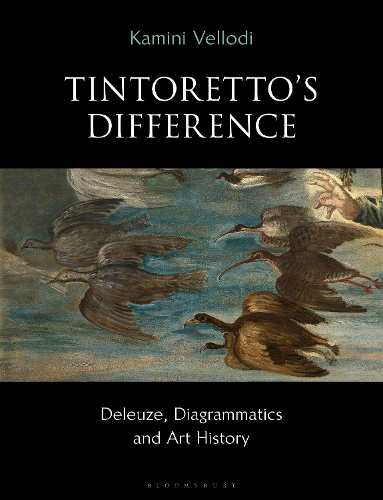
Tintoretto's Difference: Deleuze, Diagrammatics and Art History
(Hardback)
Publishing Details
Tintoretto's Difference: Deleuze, Diagrammatics and Art History
By (Author) Kamini Vellodi
Bloomsbury Publishing PLC
Bloomsbury Academic
27th December 2018
United Kingdom
Classifications
Tertiary Education
Non Fiction
History of art
Philosophical traditions and schools of thought
Structuralism and Post-structuralism
Theory of art
759.5
Physical Properties
Hardback
240
Width 189mm, Height 246mm
721g
Description
A provocative account of the philosophical problem of difference in art history, Tintorettos Difference offers a new reading of this pioneering 16th century painter, drawing upon the work of the 20th century philosopher Gilles Deleuze. Bringing together philosophical, art historical, art theoretical and art historiographical analysis, it is the first book-length study in English of Tintoretto for nearly two decades and the first in-depth exploration of the implications of Gilles Deleuzes philosophy for the understanding of early modern art and for the discipline of art history. With a focus on Deleuzes important concept of the diagram, Tintorettos Difference positions the artists work within a critical study of both art historys methods, concepts and modes of thought, and some of the fundamental dimensions of its scholarly practice: context, tradition, influence, and fact. Indicating potentials of the diagrammatic for art historical thinking across the registers of semiotics, aesthetics, and time, Tintorettos Difference offers at once an innovative study of this seminal artist, an elaboration of Deleuzes philosophy of the diagram, and a new avenue for a philosophical art history.
Reviews
An ambitious and well-orchestrated monograph that seeks to address emerging problems in diverse but contiguous domains ... [A] complex but gratifying inquiry. * Pli: The Warwick Journal of Philosophy *
An important contribution to a genuinely philosophical study of a painter. This book is both a brilliantly argued and highly original study of Tintoretto. It is one of the first to attempt to interconnect the art historical and the philosophical and needs to be viewed as integral to the creation of a new field of study. * Andrew Benjamin, Professor of Philosophy and the Humanities, Kingston University, UK *
Even the most reflective contemporary art history continues to imagine artistic practices as puzzles posed to the discourse of their time. From T.J. Clark's reading of Manet to Georges Didi-Huberman's interpretation of Fra Angelico, the move is to reveal how critical discourse is stalled or ruined by the apparently inassimilable artwork. This strategy is supported by art history's sense of theories and theorists. As an alternative Vellodi suggests Deleuze, for whom such arguments subordinate "difference to the identical." This is an exemplary book: Vellodi reads historical sources together with the recent past of art history, in order to present a "diagram" of Tintoretto in which the present is fully implicated. It is a model of thoughtful writing on art. * James Elkins, Professor of Art History, Theory and Criticism, School of the Art Institute of Chicago, USA *
Vellodis book is destined to become one of the classic studies of Tintoretto, not because it offers a new interpretation of his work, but because it sees Tintorettos paintings as an ongoing affront to the discipline of art history. As such, Vellodi winds up proposing a radically new approach to the history of art that is inspired by Deleuze, one that focuses less on Tintorettos historical context than his difference from that context. A ground-breaking and revolutionary book. * Daniel W. Smith, Professor of Philosophy, Purdue University, USA *
With assured thought and lucid prose, as well as a masterful pacing that allows her initially to broach but also to revisit and further develop complex ideas, Vellodi presents not only an original thesis about Tintorettos stage-method and a masterful understanding of the philosophy of Gilles Deleuze, but a work that traverses each as a method of demonstrating art-historical thought at work. * Art History *
Author Bio
Kamini Vellodi is Lecturer of Contemporary Art Theory and Practice at Edinburgh College of Art, University of Edinburgh, UK.
